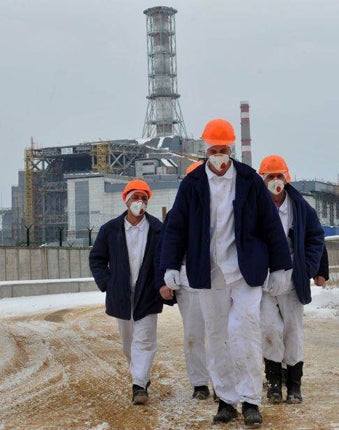Super-structure to cover Chernobyl preventing radiation from escaping for the next century
A £1.2 billion super structure will cover the nuclear wasteland to stop radiation escaping for the next 100 years

A £1.2 billion super-structure is to be built over the Chernobyl nuclear wasteland preventing radiation from escaping for the next century.
On April 26 1986, nearly 30 years ago to the day, the world witnessed the worst nuclear accident in its history.
A power failure simulation led to an explosion at the Chernobyl Nuclear Power Plant in the town of Pripyat, then in Ukraine SSR, part of the Soviet Union.
The accident is one of only two level seven disasters – the maximum classification – ever given by the International Nuclear Event Scale. The other is Fukushima.
The catastrophe directly claimed the lives of 31 people.
Roughly 50,000 residents of the nearby town of Pripyat, where the workers were housed, were hastily evacuated.
But in the ensuing clean-up hundreds of thousands of people were exposed to deadly radiation, thought to have contributed to a host of illnesses people later developed, such as cancer.
In addition, the explosion spewed nuclear particles into the atmosphere, and a potentially deadly cloud swept over much of the Western USSR and Europe.
The long-term health complications and eventual death toll from the fall-out from Chernobyl remain hotly contested to this day.
In an attempt to halt the worst of the radiation spreading, a slab of concrete referred to as the sarcophagus was hastily built over the reactor.
Decades later, a more permanent solution to the disaster is nearing completion, with the construction of a $1.7 billion (£1.2 million) ‘giant arch’ underway.
The steel-encased structure, weighing 30,000 tonnes, has received funding from the European Bank for Reconstruction and Development (EBRD), as well donations from 40 governments.
The world’s largest land-based moving structure, dubbed the ‘New Safe Confinement’ arch, it will be slowly pulled over the site later this year.
Visible for miles around, it is hoped the feat of architecture will block radiation from seeping out for the next 100 years, and will allow the remains of the reactor to be dismantled safely.
Vince Novak, nuclear safety director at the EBRD, said: "We've already gone through a number of very risky stages.
“We always have fears, we are people, but there is nothing technical left that is a challenge."
But despite the super-structure, the exclusion zone measuring roughly 1,615 square miles - the size of Luxembourg - will still be uninhabitable and closed to unauthorised visitors.
For the past 30 years Pripyat has been a ghost town, an eerie snapshot of nature retaking a town deserted by humans.
Personal belongings sit in houses exactly where they were left; toys and books remain untouched in silent schools.
A lifetime of everyday objects lay littered across the wasteland, which still lies under the shadow of the hammer and sickle, one enduring reminder of the largest communist regime in history.
Join our commenting forum
Join thought-provoking conversations, follow other Independent readers and see their replies
Comments
Bookmark popover
Removed from bookmarks